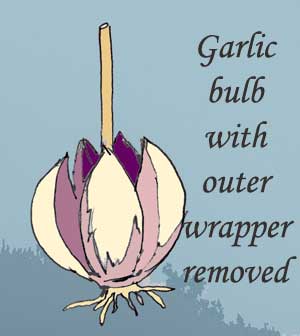First Time Garlic Grower's Guide: Or Garlic for Beginners
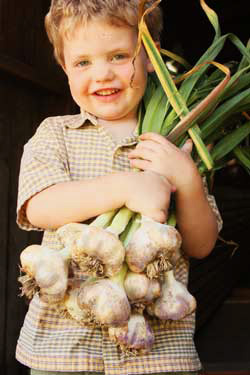 Are you new to garlic growing?
Are you new to garlic growing?
Garlic can be a great crop for beginning gardeners or growers. This guide will help answer your questions about garlic such as:
How to select the best variety of garlic
Preparing the perfect garlic bed
How to plant garlic cloves
Growing garlic naturally
Common plant problems
Harvesting and curing garlic
Picture: Ollie, an enthusiastic new garlic grower, holds a fine crop of Thermadrone, a softneck French garlic. Garlic can be an easy and fun crop to grow even if you have little gardening experience.
SELECTING GARLIC
-
What variety of garlic should I grow?
-
How much garlic do I need to plant?
-
Should I buy cloves or bulbs?
-
When is seed garlic available?
GARLIC GROWING HINTS
CHOOSING A GARDEN SITE AND SOIL PREPARATION
-
How should I choose a garden location?
-
What type of soil is best for garlic?
-
How should I amend the soil?
GARLIC PLANTING
CARING FOR GARLIC PLANTS
-
What should I do if my garlic pokes out of the ground in the spring?
-
Why didn't my garlic cloves sprout?
-
When do I fertilize garlic?
-
Does garlic need weeding?
-
Do I need to remove the scape (false seed head)?
HARVESTING GARLIC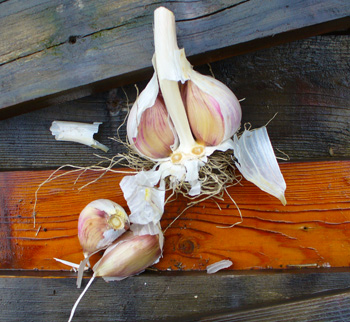
Picture: Georgian Crystal bulb split to show the large cloves.
QUESTIONS TO PONDER
-
Have you ever grown garlic before?
-
How much garlic do you need?
-
What is the meaning of garlic, anyway?
SELECTING GARLIC
What variety of garlic should I grow?
Two easy grow garlics for beginners are Georgian Crystal and Siberian. Thermadrone and Siberian are good for Southern growers.
You can also select garlic by taste:
- Hot: Parvin, Romanian Red
- Medium: Georgian Crystal, Tzan, Red Rezan, Lorz Italian
- Mild: Siberian, Bogatyr (midway between mild and medium), Thermadrone
- Sweet: Asian Tempest, Chesnok Red
Click here for more on selecting garlic varieties.
How much garlic should I plant?
Beginners may want to start with a variety planting pack to try out different types of garlic. If you need to grow a certain poundage of garlic, say you want ten pounds to last you through-out the winter or 25 pounds to give as gifts see our page on calculating garlic yield.
Should I buy seed bulbs or seed cloves?
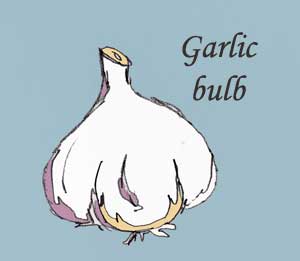 It depends on what you want. Bulbs will have different sized cloves and you will have some waste due to the weight of the wrapper. Plus it takes some time to unwrap and separate out the cloves for planting. It is hard to predict how many cloves will be in a bulb (you can estimate for some varieties but there is always a little uncertainty). On the other hand, bulbs are cheaper, you can see what the garlic looks like and it can be fun to get a variety of clove sizes.
It depends on what you want. Bulbs will have different sized cloves and you will have some waste due to the weight of the wrapper. Plus it takes some time to unwrap and separate out the cloves for planting. It is hard to predict how many cloves will be in a bulb (you can estimate for some varieties but there is always a little uncertainty). On the other hand, bulbs are cheaper, you can see what the garlic looks like and it can be fun to get a variety of clove sizes.
If you are planting only a small area, either option is good. If you are planting a large area you may prefer either the convenience of presorted cloves or the fact that bulbs are slightly cheaper. Quite frankly, there have been many times that I wished my planting garlic came pre-cloved, sized and in weighed and measured bags.
When is seed garlic available?
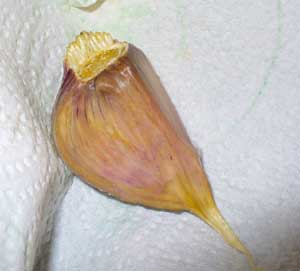 Photo: A large garlic seed clove starting to grow roots at the flat base. This plump clove is starting to grow and ready to plant. Garlic cloves may or may not have roots when you plant them. Roots start developing in response to cold and moisture. Garlic cloves send out roots first and shoots later.
Photo: A large garlic seed clove starting to grow roots at the flat base. This plump clove is starting to grow and ready to plant. Garlic cloves may or may not have roots when you plant them. Roots start developing in response to cold and moisture. Garlic cloves send out roots first and shoots later.
Garlic cloves and bulbs are available in late summer to early winter. Most websites pre-sell garlic beginning in late winter/early summer of the previous year.
Most farms, farmer's markets or nurseries sell garlic as bulbs and charge either per pound or per the bulb. You can usually buy large or medium bulbs to plant and sometimes small bulbs to eat.
GARLIC GROWING HINTS
CHOOSING A GARDEN SITE AND SOIL PREPARATION
How should I choose a garden location?
Garlic is planted in the fall or early winter so it is important to have a spot prepared for planting. If possible, select a garden site that is in full sun. If that is not possible choose one that gets partial sun in the heat of the day.
If it is a new garden spot make sure that the area has not been treated with any long acting herbicides. Several of our former customers had problems with herbicide residue in the soil. These chemicals can stay in the soil for several years. Herbicides can stunt or kill any garlic or vegetables you try to grow in the area. Failure to grow and stunted ,twisty growth can indicate herbicides.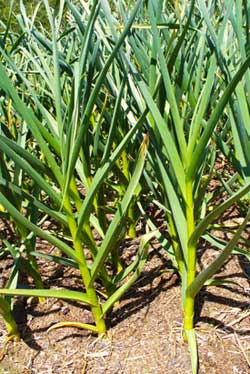
Picture: A healthy stand of hardneck garlic. The more leaves the garlic plant grows, the bigger the bulb on average. These vigorous plants have 9-11 leaves each which is considered excellent (on average garlic has 7 leaves).
Long lasting herbicide are commonly used in lawn care. If you have a lawn service, ask what they use in the area (especially if your grass is suspiciously weed free). If you suspect herbicide residue plant a test plant or two in the area to see what happens. Tomatoes are good indicator plants since they are very sensitive to chemicals.
What type of soil is best for garlic?
Since garlic is a root crop it needs a fertile loose soil with good drainage. Silty loam is one of the best soils for garlic. Garlic will not grow well in wet or soggy soil. It will rot.
How should I amend the soil?
Remove weeds and dig soil well (if you start soil preparation in summer weeds can be turned in as green manure). Add organic matter such as compost, peat moss, hay, manure or any other non-treated plant residues. Garlic loves manure and compost; you cannot have too much. No really, you can plant a garlic clove in a big chunk of manure and it will think it has gone to garlic heaven.
Till or dig soil so it is loose and 'fluffy'. Root crops grow best in light, non compacted soil. Garlic cannot grow in concrete.
If you have sandy or clay soil add organic matter. DO NOT add sand to clay soil or you will end up with cement; good for driveways bad for planting beds. Organic matter will hold moisture in sandy soil and break up clay soil. For an expanded section on soil amendment see how to grow organic garlic.
GARLIC PLANTING
When is garlic planted?
Garlic is planted in fall to winter. We plant our garlic in late October to early November after the first hard frost. Several studies have shown that the later planted garlic has larger bulbs than earlier planted garlic.
How do I plant garlic?
Choose big cloves for big garlic (eat the small cloves). Or use small cloves to grow green garlic.
Plant separate cloves: Garlic is planted by separating the cloves from the base of the bulb. Cloves are the sections of the bulb that you see when you peel back the papery outer layers or wrapper of a garlic bulb. Each clove is cover with either a hard or a papery wrapper.
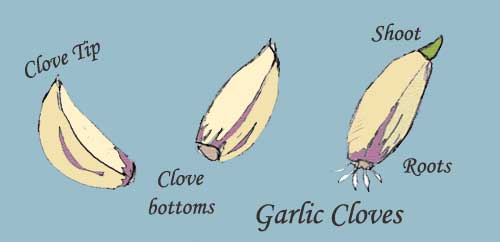 Leave on clove wrappers: The outer papery or hard clove wrapper helps protect the garlic clove as it grows. We recommended leaving the clove wrapper on the clove when you plant.
Leave on clove wrappers: The outer papery or hard clove wrapper helps protect the garlic clove as it grows. We recommended leaving the clove wrapper on the clove when you plant.
Plant garlic cloves pointy end up: The pointy end or tip is the top of the clove (see illustration). Plant the tip right side up. If you plant the clove upside down you will have deformed bulbs.
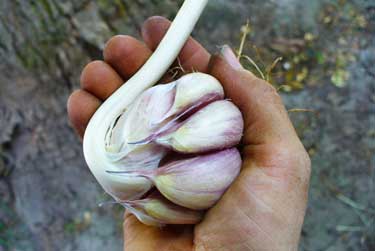 Picture: Deformed bulb from a clove accidently planted upside down. The stem has to twist to grow up. The bulb was still good to eat but wasn't very pretty! Can you tell we don't use hand models for these field photos?
Picture: Deformed bulb from a clove accidently planted upside down. The stem has to twist to grow up. The bulb was still good to eat but wasn't very pretty! Can you tell we don't use hand models for these field photos?
Plant cloves several inches deep: make sure that the garlic clove is covered by several inches of soil.
Mulch: cover the planting bed with with several inches of straw, compost or wood chips after planting. Mulch helps keep garlic cloves from heaving out of the ground and modulates temperature extremes. Warning: if your winters or springs are really wet straw may cause fungus or molds to grow at the base of the garlic stem. Some people use straw without problems; it depends on your climate.
See our how to grow organic garlic page for more on planting.
CARING FOR GARLIC PLANTS
What should I do if my garlic pokes out of the ground in the spring?
Garlic planting cloves sometimes comes out of the ground in early spring. This is either due to the heaving of the soil due to the freezing thawing cycle or to fast root growth literally lifting the clove out of the ground. We either gently poke the garlic back under the soil or dump a little loose soil or compost on top of the garlic. Susan usually spends a couple of hours in early spring scouting the field for popped up garlic!
Why didn't my garlic cloves sprout?
Garlic cloves may have been eaten by voles, hollowed out by wieworms, or may have rotted due to soggy soil. Please see our frequently asked questions page for a complete discussion of why garlic cloves may not sprout.
When do I fertilize garlic?
Garlic is a nitrogen hog. It likes lots of nutrients. In addition to adding compost to the planting bed, we usually fertilize twice more with nitrogen. Once after we plant and once in early spring when the garlic is a few inches high.
Garlic also needs potassium to develop large bulbs. Due to all the manure we dump on our soil, our garlic plot already contains high levels of potassium. That means we don't need to add any extra.
Use soil tests to determine what nutrients you need to add to your garden for large healthy garlic. Soil tests help determine what nutrients are missing in your soil. Often your local extension agency or university can direct you to a affordable place to test soil. We do a comprehensive soil test each year.
Using the results of the soil test, you can customize the nutrients you add to your garden plot. This way your plants get the nutrients they need and you don't waste fertilizer. Adding too much fertilizer can cause excess nutrients to run off downstream or into the groundwater. This pollutes the water and causes problems like nitrate poisoning of groundwater and algae blooms due to excess phosphorus.
Does garlic need weeding?
Yes, if you want to have decent sized bulbs. If you don't weed your garlic will be really small. Studies show that garlic yield can be reduced by half due to weed competition. Check out our weed control advice for weed control the easy way. 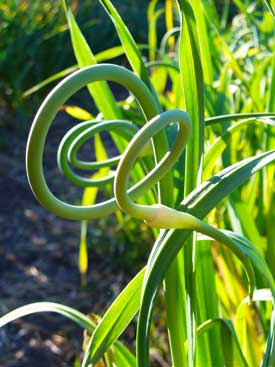
Picture: Hardneck garlic grows a false seed head called a scape in early summer. This seed head actually contains small garlic bulbs called bulbils. Bulbils can grow into regular garlic bulbs but it takes 2-3 years (or longer).
Do I need to remove the scape (false seed head)?
Some studies show that if you remove the scape (or false seed head) the garlic devotes more time to growing a bulb. As a result, bulbs are bigger. We have tried removing or not removing scapes and noticed that bulbs are slightly bigger on the plants without scapes. This seems to be a bigger factor on tough years when garlic has less resources to devote to both bulbs and scapes.
In addition, some people like to eat the garlic scapes. To harvest garlic scapes, cut them off when the scapes are still young and have several whorls in the stem (as seen above). young small scapes are tender. When the scape straightens out it becomes tough.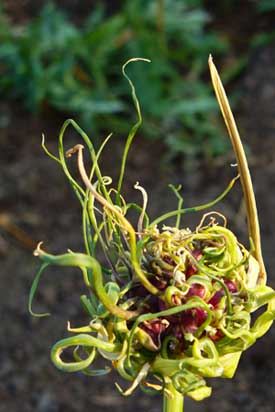
Picture: a mature scape in mid-summer showing the developing garlic bulbils. This scape would be a bit tough to eat (although some people like to cook the little bulbils).
HARVESTING GARLIC
When do I harvest garlic?
Garlic is harvested in late summer. Not all garlic varieties are ready at the same time. Usually turban and softneck garlic are harvested the earliest. Carefully dig up garlic to avoid breaking off the bulb (if your soil is loose you may be able to pull garlic). Watch out that you do not slice the bulb. From my experience, it is always the biggest bulbs that get sliced (and then the crying begins).
Dig hardneck garlic up when about half of the garlic's leaves are dried and brown. Dig softneck garlic up when about a third of the plants flops over. Handle garlic carefully, it can get bruised. For pictures on harvest see our frequently asked questions page.
If you irrigate, stop watering a week or two before harvest to allow the garlic to mature. You don't want the plant too wet when you harvest. It makes drying difficult and can rot bulbs.
How do I cure and store garlic?
Curing bulbs properly is vital if you want to store bulbs to eat later in the winter. In curing, bulbs lose some moisture and develop a richer flavor. Curing helps to prevent rot in storage.
Picture: Three cured hardneck Red Rezan garlic bulbs sit in a row.
After you dig garlic wipe off any extra dirt or mud from the bulb. Leave garlic on its stalk and lay or hang it in a cool, shady area. It is important to allow air low or ventilation around the garlic.
We usually leave the roots on the garlic to cure, however, if you live in a very humid area you may wish to cut off the roots. Garlic can absorb moisture through the roots and this can impede drying time or cause garlic to rot. If we harvest during a very wet summer, we have to cut off the roots on our softneck garlic to allow it to dry quickly. Softneck garlic is 'juicier' than hardneck garlic (especially big bulbs) and sometimes needs more attention during drying.
Curing takes from 2-4 weeks depending on weather, drying conditions and juiciness of the garlic bulb. Once the stalk dries you can cut off the stalk and the roots and let the bulbs cure further. As you can see from the photo above, we like to leave a longer stem on the garlic (1/2 inch or so) and about 1/4 inch of the roots. Cutting off the stalk before it dries fully has been shown to cause an increase risk of bulb rot in storage (rot pathogens can enter through the wet cut stem).
We store our bulbs several bulbs deep in greenhouse flats. This allows air movement around the bulbs and easy access. See our page on garlic storage for advice on keeping garlic over the winter.
QUESTIONS TO PONDER
Have you ever grown garlic before?
New growers should start with a reasonable amount of seed cloves and build their way up. Try out a small amount of garlic to see if you even like growing it. If you haven't grown garlic before you may want to think twice about ordering enough to plant an acre. We usually only plant 1/2 -2/3 acre (it is pretty intensive).
How much garlic do you need?
Grow as much garlic as you think you will need. Make sure to factor in the fact that relatives and friends may start requesting a bulb or two or eight. Gourmet garlic also makes great gifts for cooks and gardeners (we get a lot of requests for our smelly bulbs). We also find it is a great donation to local food pantries.
What is the meaning of garlic, anyway?
Contemplate a perfect garlic bulb. Garlic can be food, serve as a vampire repellent, change epigenetics, prevent food poisoning, cause strong breath, act as medicine, absorb toxins and leisure wear (just seeing if you were paying attention although some people do wear garlic costumes). Garlic can even be a source of artistic inspiration and beauty; I find it amazing that I can easily devote a entire website to garlic! Other people have devoted weekend festivals to this humble herb. What does garlic mean to you?

